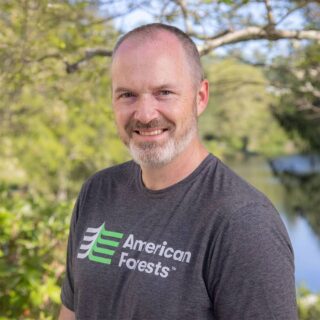Thornforests Are Feeling the Heat
Climate change is altering the Rio Grande Valley so swiftly that some plants will no longer be able to survive in certain areas. Not only is the region seeing increasingly severe drought and heat, but violent storms are also becoming far more common. American Forests’ climate resilience strategy is a suite of forestry tactics that aims to grow thornforests that can better adapt to a changing climate.
How Does Climate-Smart Reforestation Work?
Our climate resilience strategy, developed in partnership with the U.S. Fish and Wildlife Service, is an evolving suite of planting techniques that includes:
- Planting a diversity of species. We plant up to 30 native plant species at each site, with an emphasis on drought-tolerant species. In addition to drought, certain species may prove to be more tolerant of heat, flooding and other stressors.
- Planting seedlings that are better adapted to climate change. We collect seeds from different sites and parent plants across the Rio Grande Valley, helping to ensure genetic diversity in the seedlings we plant. Certain plants may have genes that confer resistance to low water, or high heat — helping boost the forest’s adaptability to climate change.
- Removing invasive weeds from planting sites. Aggressive invasive grasses are a major issue in this region, as they can outcompete native plants. American Forests removes invasive species from planting sites by using heavy machinery, selective herbicide applications and/or controlled fires.
- Sheltering seedlings in tubes. Reusable tubes protect seedlings from drying out or being eaten by animals. These tubes encourage seedlings to grow tall and develop deep roots, which helps them outcompete invasive plants. In some cases, shelter tubes have boosted two-year seedling survival rates from less than 10% to over 90%.
Drought Resiliency in Action
In 2020, American Forests and the Fish and Wildlife Service carried out the first planting to use our climate resilience strategy. We planted 70,000 thornforest seedlings across 70 acres of abandoned farmland on the southern shore of a unique salt lake known as La Sal del Rey, located in the Rio Grande Valley National Wildlife Refuge.
All American Forests plantings in the Rio Grande now follow our climate-resilient methodology. In 2021, we planted a total of 125,000 seedlings at Ranchito, a tract of land owned by the Fish and Wildlife Service, and at Laguna Atascosa National Wildlife Refuge. We are actively monitoring the health of these plantings and will publish scientific research about the success of climate-resilient reforestation in coming years.
Video Credit: DDC International / American Forests




